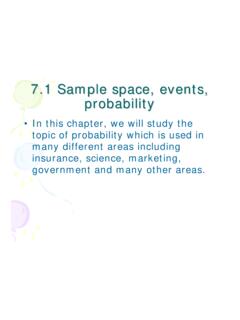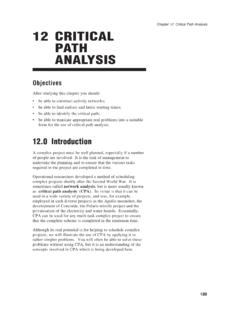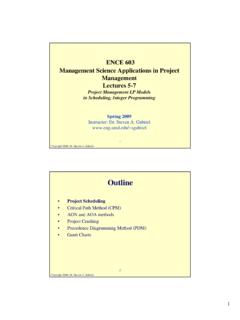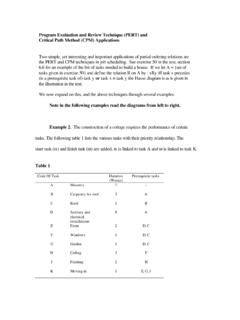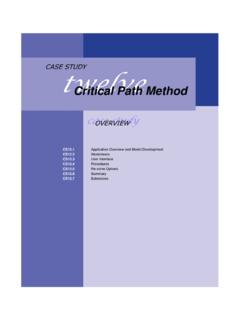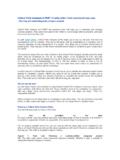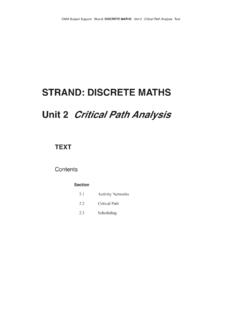Transcription of Critical Incident Technique - Governors State University
1 Critical Incident Technique Training Workbook Copyright 2014 LR Gordon, Incorporated 1 Copyright 2014 LR Gordon, Incorporated. Introduction In this lesson you will learn about the Critical Incident Technique , which is a tools that is used to conduct front-end analysis. Within this lesson, you will also learn of the six steps involved in performing the Critical Incident Technique . All Critical Incident Technique terminal behaviors and most enabling behaviors will be outlined within this structured lesson. Survey results have reflected a knowledge deficiency, therefore additional instruction will be provided on the three topics below. Sorting factors using Behaviorally Anchored Rating Scale (BARS); Filling gaps on Bars; Editing recorded incidents. The purpose of the Critical Incident Technique is to gather information (war stories) on behaviors that contribute to the success or demise of performance.
2 These incidences or war stories were observed and are shared via written reports or oral interviews. War stories are facts derived from peers, subordinates, customers, vendors and management. The result of this Technique according to Zemke and Kramlinger (1982), are reports or descriptions of things people in the studied population report having done or have been observed doing by others (p. 129). The benefit of using the Critical Incident Technique is that once all of the steps have been completed, training professionals will have behavioral data that can be used for various training based exercises. Other benefits of this Technique is that it is inexpensive and procedurally flexible. The Critical Incident Technique is unique in that it can uncover or identify rare behaviors or tasks that effect performance. Overall, this Technique provides a wealth of organizational information from a personal perspective.
3 The importance of this Technique is that it can be used to measure and evaluate both end-of-training and on-job behavior . (Zemke and Kramlinger, 1982, p. 130) Also, along with being a benefit, this Technique is once again an important and effective tool used to capture data on individual job behaviors and tasks. In the previous lesson you learned about the Stimulus Response Table (S-R table) Technique . According to Zemke and Kramlinger (1982), this task analysis Technique is a more sophisticated form of the task-listing approach (p. 39). Just like the S-R Table Technique , the Critical Incident Technique uses observations to obtain data on job performance and or behaviors. And just like other techniques that have already been addressed or have yet to be addressed, the Critical Incident Technique is another investigative tool that can be used individually or part of the front- end analysis process.
4 2 Copyright 2014 LR Gordon, Incorporated. Objectives At the end of this lesson you will be able to: Explain the Critical Incident Technique ; Explain the importance of conducting the Critical Incident Technique ; Identify the 6 steps involved in the Critical Incident Technique ; Edit recorded Critical incidents; Use a Behaviorally Anchored Rating Scale (BARS). Outline Definition of Critical Incident Technique . Definition of BARS. Purpose of Critical Incident Technique . When to use the Critical Incident Technique . Six steps in the Critical Incident Technique . exercise Lesson Summary Definitions Critical Incident Technique Is a task analysis Technique that through personal narratives effective and ineffective job performance behaviors are determined and identified. This Technique is also part of the front-end analysis process. Behaviorally Anchored Rating Scale (BARS) A vertical scale with points from bottom to top.
5 The points on the scale begin at 1 and can go up to 10. Each rating on the scale is considered a performance measure, 1 being poor and 10 being good. It is a quantifiable method of appraisal. Purpose of Critical Incident Technique The Critical Incident Technique is a tool used to gather information (war stories) on behaviors that contribute to the success or demise of performance. When performed correctly, this front-end analysis tool will: Identify tasks or behaviors that lead to ineffective job performance; Identify tasks or behaviors that lead to effective job performance; Uncover overall skills, attitudes, knowledge or values that contribute to effective or ineffective job performance. When to use the Critical Incident Technique When there is a need for qualitative data. 3 Copyright 2014 LR Gordon, Incorporated. When behaviors are observable. When according to Zemke and Kramlinger (1982), there are Critical behaviors of jobs and tasks that allow a high degree of individuality.
6 (p. 139). Example You are invited to participate in a Critical Incident task analysis. The purpose of this task analysis is to determine effective and ineffective behaviors that effect job performance within various organizations. What Will You Be Asked to Do? As a SME s, you will be asked to perform the tasks below. Please allot 30 minutes to 1 hour to participate in this activity. Participate in a discussion concerning job performance behaviors. On the forms provided, record the best and worst performance behaviors, complete with behaviors that influenced each tasks. Review recorded stories and agree on identified effective and ineffective behaviors. Risks During the discussion portion of this activity, you will have to share personal observations. This may cause you to experience some discomfort. There aren t any other risks associated with this activity.
7 Benefits This activity will help performance technologist learn job behaviors that promoted effective or ineffective performance, thus helping to improve performance within a job group, department or organization. Confidentiality Your anonymity will be maintained at all times as you participate in this activity. Voluntary Participation in this activity is completely voluntary. You may choose to terminate your participation in this activity at any time. 4 Copyright 2014 LR Gordon, Incorporated. Main Lesson Now that you have finished learning the definition, purpose and application of the Critical Incident Technique , here are the actual steps need to perform this particular front-end analysis. Step Action Example 1 Create two groups of subject matter experts (SME). Gather subject experts to participate in the Critical Incident Technique . 2 Record/edit Critical incidents.
8 After brief icebreaker, have the all SME s document specific positive and negative job performance incidences on a provided form. Edit recorded responses and translate them into core statements. Write each core statement onto an index card. 5 Copyright 2014 LR Gordon, Incorporated. Step Action Example 3 Create, review and reduce factors. Factor 1 Factor 2 Sort similar core statements cards into groups. The end result is different groups that contain like core statements. These groups are called factors. Allow the SME s review, discuss and agree on individual statements. Have the SME s further reduce the number of core statements and factors. 4 Sort factors using Behaviorally Anchored Rating Scale (BARS). Sort factors into two groups positive and negative. With 7 being good and 1 being bad, for each factor, have SME s rank individual core statement cards onto the vertical rating scale.
9 A poor performance behavior should be placed at the bottom of the scale (1). A moderate behavior should be placed in the middle (3 or 4). A good behavior should be placed at the top (7). 6 Copyright 2014 LR Gordon, Incorporated. Step Action Example 5 Fill gaps on BARS. Once all core statement cards per factor have been placed on the BARS, there may be gaps that exist within the rating scale. Identify additional Critical incidences. Translate new Critical incidences into core statements and write in an index card. For each factor, post new core statements cards along the BARS, thus filling in the gaps. 6 Reconcile Critical Incident differences / discrepancies. SME s should review the completed BARS and come to an agreement that all posted Critical incidences are accurate and relevant. All BARS related disagreements should be reconciled before summarizing data. Optional Report findings to management.
10 Summarize dominate behaviors that effect job performance be it good or bad. Report findings to management. 7 Copyright 2014 LR Gordon, Incorporated. exercise Please allot 45 minutes to complete. Purpose - These exercises will give you a greater understanding on editing recorded incidents and using the Behaviorally Anchored Rating Scale (BARS). Activity 1- Edit recorded incidents You have just received 30 Critical incidents. Each Critical Incident has been recorded on an individual form that was provided by the trainer. Below, you will find a sample of the Critical incidences received. For each Critical Incident , edit the story into brief core statements. Refer to example A. Recorded Critical Incident Core Statement A. Leona used only cup of sugar for the pound cake. She did this because she ran out of sugar and figured that using less sugar would not make a difference.





